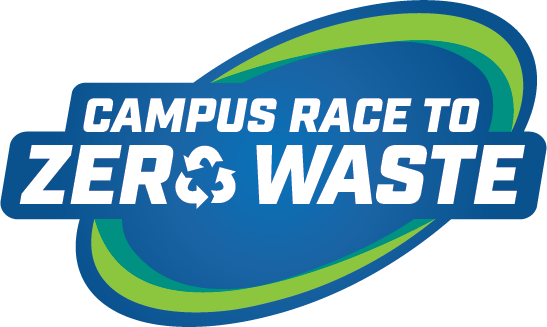Today over 1,100 colleges and universities in the U.S. and Canada have participated in the Campus Race to Zero Waste (formerly RecycleMania) program, recycling, donating and composting more than 1,064 million pounds of waste and preventing the release of nearly 1.62 million metric tons of carbon dioxide equivalent, which is comparable to removing over 335,000 gas engine passenger vehicles from the road for one year. Check out competition past results and learn more about the prevention of carbon dioxide equivalent into the atmosphere each year through campus actions.
How college and university actions to reduce waste and increase recycling have a positive impact on the climate
Waste Minimization and Recycling:
First and foremost, reducing the purchase and use of new products results in less energy needed to extract, transport and process materials to manufacture these new products. The purchase of materials made of recycled materials is also key. The processing and manufacturing of products using recycled materials uses less energy than using virgin materials, and less energy means less greenhouse gases being emitted into the atmosphere from the extraction or mining of virgin materials. For example, using recycled aluminum is 92% more energy efficient than using materials. And the recycling of paper, minimizes the need to cut trees for new paper. Trees act as natural carbon sinks and when they are cut down, the carbon dioxide they are storing goes back into the atmosphere. According to the U.S. Environmental Protection Agency, forests and other nonagricultural lands absorb a net of 13% of U.S. carbon dioxide emissions.
Each year during the Campus Race to Zero Waste competition, colleges and universities implement waste minimization and recycling strategies to reduce their campus’s waste footprint. Read about some of these strategies at Learn from your Peers case study database.
Food Waste Reduction:
One of the most popular categories of the competition each spring is the Food Organics category; more than 150 campuses compete each year in this category. The main goal of the Food Organics category is to recognize campuses that are successfully implement food waste minimization activities that address overage including portion control techniques and preparing food to order. The secondary focus for this category is how food waste recovered is managed, such as donation to people, used for biofuels, and composting. In 2019, more than 2.5 million pounds of food was donated to people and animals, and used for biofuels.
According to Food Rescue, American food production has a tremendous energy resource cost – 10% of the nation’s total energy budget, 50% of its land, and 80% of all U.S. freshwater consumption is dedicated to the production and distribution of food. An unconscionable amount of those resources are wasted completely, as up to 40% of all food ends up in landfills.
Plastics Pollution:
In 2018, the National Wildlife Federation took over the management of the Campus Race to Zero Waste program. NWF was excited about this new partnership because it saw its potential in helping to address plastic pollution in our country’s waterways - one of the biggest threats to wildlife. During the 2020 competition, colleges and universities kept more than 380 million plastic containers out of the landfill through their waste minimization and recycling practices.
According to a recent report, Plastic & Climate: The Hidden Costs of Plastic Planet, “the plastic pollution crisis that overwhelms our oceans is also a significant and growing threat to the Earth’s climate. At current levels, greenhouse gas emissions from the plastic lifecycle threaten the ability of the global community to keep global temperature rise below 1.5°C. With the petrochemical and plastic industries planning a massive expansion in production, the problem is on track to get much worse.“
Check out our new guide, Stemming the Tide: Taking Action On Campus Against Plastic Pollution. The guide features information about the plastic pollution problem, impacts on humans and wildlife, and showcases 36 campuses and their strategies to reduce the purchase and use of plastics on campus.
Resources:
